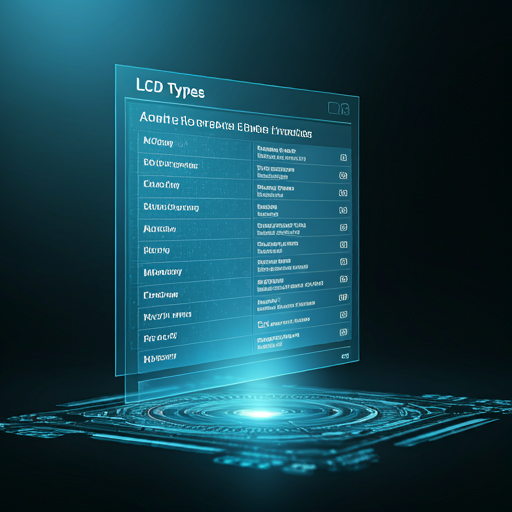Liquid crystals are a classical constituent of modern display technology. They are used nearly in all common TVs and monitors of PCs, and lately also in smartphones and industrial equipment. From one side, despite the fact that all these devices serve nearly identical kinds of primary function-showing images and information-there are other mechanisms inside of them. In this chapter we will discuss the most important types of LCDs and their characteristics and Types of LCDs.

Twisted Nematic (TN) Types of LCDs
Undeniably the most commonly used and possibly one of the oldest LCD technologies sold in the market today, twisted nematic displays have liquid crystals positioned in a twisted structure that would transmit light once the electric current is applied. Perhaps the most significant advantage of TN panels lies in their fast response time that could be very ideal for gaming and fast-moving contents.
However, TN Types of LCDs have some disadvantages also. They offer worse colour gamut and viewing angles compared to others. Colours can shift dramatically as viewed from the side. This can be unsuitable for applications such as graphic designing that demand high precision in colour accuracy.

In-Plane Switching Types of LCDs
This was designed to address the weakness of TN panels with a poor representation of colours and wide viewing angles. Using an IPS monitor the liquid crystals of the display set parallel to glass substrates to provide better colour rendering and wider viewing angles. That’s why using IPS panels is quite often made with most professional photography and video editing as well as gaming since the produced visuals are of high quality.
Although the image quality for IPS panels is much better, they are often slower in terms of response time than TN. The former could even cause motion blur in a scene that moves very fast because it might make the scene move too fast. Also, the VA LCD process produces costlier for consumers due to its pricier production process of Types of LCDs.

VA Types of LCDs
VA LCDs- a blend of TN and IPS. In a VA panel, no voltage applied across the display would align the liquid crystals more or less perpendicularly. Therefore, high contrast ratios and deep blacks result from VA-based displays. Thus, these are pretty good for movie watching or games played in dark rooms.
However, VA panels respond relatively slower compared to in IPS display and have narrower viewing angles. Not as good on color accuracy as an IPS panel, though; if people want something that’s both strong in gaming and multimedia, they might not have a problem with these Types of LCDs.

Advanced Fringe Field Switching (AFFS) Types of LCDs
Advanced fringe field switching, on the other hand is one of the derivatives that progress the same IPS technology with better colouring capabilities and wider viewing angles. AFFS displays can boast heightened brightness even in attaining high contrast ratios and makes them ideal for outdoor use where the need for visibility is very essential. It is often used in high-end smartphones and professional monitors.
This provides several advantages, but its prices are pretty steep for such a clumsily manufactured process. Still, for professionals that make huge demands on the visual performances of high quality, it is surely worth the buck.
Organic Light Emitting Diode (OLED) and Mini-LED
While not traditional LCDs, a mention of newer technologies, such as OLED and Mini-LED, is to be noted. Since OLED panels rely more on shadow where there is no backlight, they produce much deeper blacks and better contrast. Mini-LED enhances the regular LCD using tinier backlights than compared with regular LED. These support brightness and contrast.
These two technologies have received appreciations of great magnitudes and are often set for comparison against LCDs in terms of their performance. OLED displays are highly demanded in high-end television and smartphones based on their excellent picture quality.
Conclusion
Of course, just like any other display technology, Types of LCDs also vary widely in their needs and preferences. While some may be stronger with regards to colour accuracy than others, for example one fast TN panel can really ensure better colour accuracy than an IPS display, in this way understanding the differences, consumers as well as professionals could make a choice in choosing the right display technology for the intended application or use – be it gaming, content creation, or another area of casual use. New generations will certainly unleash even more technologies in order to keep up with the requirements of the users of Types of LCDs.
FAQS
What is the best type of LCD display ?
These are the main types of LCD panels. Because of their improved image quality, wider viewing angles, vivid color precision, and distinctiveness, IPS displays are recognized as the best LCDs.